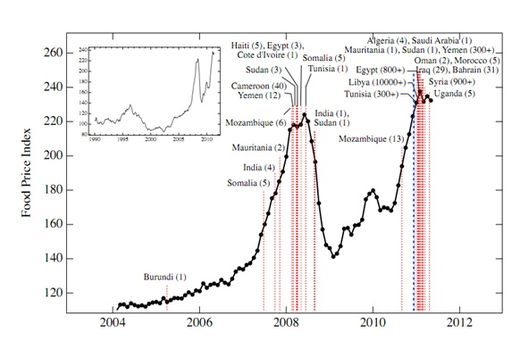I don’t mean to put a damper on the everyone’s summer holidays, but the current heatwaves in the U.S. and Europe has me thinking back to numerous warnings issued during last summer’s major drought and “record-breaking heatwave” in the U.S.
Analysts at Rabobank, a Netherlands-based bank specialising in food and agri-business financing, were crunching the numbers and predicted at the time that food prices, specifically meat prices, would soar in 2013 as a result of the U.S. drought.
Back in 2011, the New England Complex Systems Institute (NECSI), a research body of academics from Harvard and MIT, using data from the UN Food and Agriculture Organization’s (FAO) Food Price Index, published a paper that correlated “outbreaks of unrest” in 2008 and 2011 with increases in food prices. They claimed to have identified the precise threshold for global food prices that leads to worldwide unrest: 210 points…
“high global food prices are a precipitating condition for social unrest. More specifically, food riots occur above a threshold of the FAO price index of 210.”

Yaneer Bar-Yam, president of NECSI and one of the paper’s authors, said:
“When people are unable to feed themselves and their families, widespread social disruption occurs. We are on the verge of another crisis, the third in five years, and likely to be the worst yet, capable of causing new food riots and turmoil on a par with the Arab Spring.”
The aggregated FAO Food Price Index averaged 211.3 points in June this year, but more telling indicators might be their June 2013 Cereal Price Index, which averaged 236.5 points, and their Sugar Price Index, which averaged 242.6 points. Dairy prices are also riding above this 210 threshold, so when we consider that most people’s diets are substantially based on sugar, cereals and dairy, followed by meats from cattle raised on grains, it seems pretty clear that we’re very much in the danger zone.
In fact, the NESCI paper, ‘The Food Crises and Political Instability in North Africa and the Middle East’, went further and forecast the highest risk of global unrest for August 2013.
“When you have food prices that peak, you have all these riots. But look under the peaks, at the background trend. That’s increasing quite rapidly, too,” said Yaneer Bar-Yam. “In one to two years [from 2011], the background trend runs into the place where all hell breaks loose.”
The Food Crises and Political Instability report doesn’t simply compile the correlation between food prices and political uprisings, but also projects a certain global threshold when food price trends might rise significantly enough to spark global unrest. According to the NECSI, the world will reach its food price threshold in August 2013.
Compounded by speculators in the commodities markets “making a killing” on the food crisis, prices for staples like corn and wheat rose nearly 50% on international markets last summer. The Organisation for Economic Cooperation and Development (OECD) predicts that rising global food demand will “push up prices 10 to 40 percent over the coming decade” [that is, between 10 and 40 percent higher than their current highs].
Meanwhile the UN has warned that world grain reserves are so dangerously low that “severe weather in the U.S. or other food-exporting countries could trigger a major hunger crisis in 2013.”
‘Green guru’ Lester Brown, president of D.C.-based think-tank, the Earth Policy Institute, says the climate is “no longer reliable” and that demands for food are growing so fast that a breakdown is inevitable:
“Food shortages undermined earlier civilisations. We are on the same path. Each country is now fending for itself. The world is living one year to the next… Climate is in a state of flux; there is no normal any more. We are beginning a new chapter.”
Here’s what Abdolreza Abbassian, a senior FAO economist, had to say about the global food crisis last year:
“We’ve not been producing as much as we are consuming. That is why stocks are being run down. Supplies are now very tight across the world and reserves are at a very low level, leaving no room for unexpected events next year.“
Yes, that means there’s no room for unexpected events this year (2013).
China, normally the world’s second largest surplus exporter of wheat, just this week announced that it will be importing wheat from the U.S. this year, following major crop failures resulting from the northern hemisphere’s record-breaking cold, wet spring.
But the U.S. isn’t faring any better, with the 2012 drought extending into this year and condemning the growing season before it even started. Far from producing “no unexpected events”, 2013 is producing even wilder weather extremes than ever before.
Buckle up: we’re in for a rocky ride…


 This, if nothing else, will be interesting to watch.
This, if nothing else, will be interesting to watch.